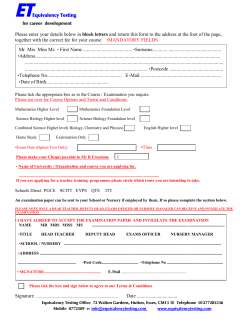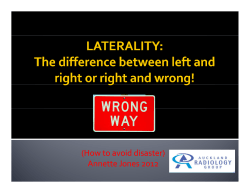
Document 248274
Congratulations!!! You are to be commended for your participation Orthopedic Specialist Certification Examination I applaud your active commitment to improvement and specialization 2010 In my estimation – you represent the best the profession has to offer and you’re seeking the most impressive credential our association bestows Why you’re doing this …… 9409 ABPTS Board Certified Clinical Specialists Physical Therapists with OCS are more efficient when compared to non-OCS clinicians - Hart DL, et al. JOSPT, 2000. – – – – – – – – – – improved sense of personal achievement increased self confidence increased prestige in a clinical setting positively affected patient care more interesting and fulfilling career increased prestige in an academic setting increase prestige of professional association increased invited presentations increased new job opportunities opportunity for increased responsibility – 96% – 86% – 83% – 75% – 72% – 68% – 67% – 52% – 44% – 43% Preparation and Study Self Assessment using DSP to determine areas of weakness for increased focus – – – – – – – Find a comprehensive review chapter or article Be familiar with guide terminology Review Courses Ortho Section Home Study Courses Ortho Section Current Concepts Courses (12 monographs) Literature review – current test is based on 1999-2001 survey, test questions, and input Teach someone what you’re learning Specialty Area Number of Certified Specialists Cardiopulmonary 138 Clinical Electrophysiologic Geriatric 139 1006 Neurologic Orthopedic Pediatric 747 5590 943 Sports Women’s Health 775 61 Tidbits from CSM meeting 2007-08 literature findings can not theoretically be on the exam “guide correct” Committee of content experts have tried to eliminate philosophy bias and terminology Too many elbow … too much McKenzie … too much spine …. too much research …. – I read those questions ten times so it seems like there was more of that What Textbooks? Orthopedic Physical Assessment – – Orthopedic Manual Therapy – – David J. Magee W.B. Saunders, 4th Edition 2002 Chad Cook Prentice-Hall, 2006 – Current Concepts of Orthopedic Physical Therapy 2002 (may no longer be available in print) – 12 monographs - $215 Current Concepts of Orthopedic Physical Therapy 2006 – PT Journal JOSPT APMR Spine AJSM Manual Therapy David J. Magee, James E. Zachazewski, William S. Quillen Saunders, 2007 Independent Study Courses Scientific Foundations and Principles of Practice in Musculoskeletal Rehabilitation – What Journals? 12 monographs - $225 Current Concepts Content Clinical Reasoning and Evidence-based Practice—Nicole Christensen, PT, MAppSc, OCS, FAAOMPT Physical Therapy Management Utilizing Current Evidence: – The Cervical Spine—Joshua A. Cleland, DPT, OCS; John D. Childs, PT, PhD, MBA, OCS, FAAOMPT; and Mark Jones, PT, MAppSc, MAPA, MMPA – – – – – – https://www.orthopt.org/store.php?user_level=2&type=2 – – – – Assignment and Alycia M. Markowski, PT, MPhySt, FAAOMPT The Thoracic Spine—William Egan, PT, OCS and Timothy W. Flynn, PT, PhD, OCS, FAAOMPT The Shoulder—George J. Davies, DPT, MEd, PT, SCS, ATC, LAT, CSCS, FAPTA; Kevin Wilk, DPT; Todd Ellenbecker, MS, PT, SCS, OCS, CSCS; Tim Tyler, MS, PT, ATC; Michael M. Reinold, PT, DPT, ATC, CSCS; Bryan Heiderscheit, PhD, PT; Micheal A. Clark, DPT, MS, PT, PES; Rob Manske, MEd, MPT, SCS, ATC, CSCS; James W. Matheson, DPT, PT, SCS, CSCS; Daniel J.R. Kraushaar, MPT, CSCS; and Mike Mullaley, MS, PT The Elbow—Chris A. Sebelski, PT, DPT, OCS, CSCS The Wrist and Hand—Carolyn Wadsworth, PT, MS, OCS, CHT The Lumbar Spine—Julie M. Fritz, PT, PhD, ATC The Pelvis and Sacroiliac—Michael T. Cibulka, PT, DPT, MHS, OCS The Hip:—Phillip S. Sizer Jr, PT, PhD, OCS, FAAOMPT The Knee—Tara Jo Manal, PT, OCS, SCS and Lynne Sturgill, PT, MHS, OCS The Foot and Ankle—Stephen F. Reischl, PT, DPT, OCS and Lisa M. Noceti-DeWit, PT, DPT, ATC The Temporomandibular Joint—Nancy Adachi, PT, BA; Mary Ann Wilmarth, PT, DPT, MS, OCS, MTC, Cert MDT; and Robert L. Merrill, DDS, MS Resources Second Recommendation Order a copy of the Orthopedic Description of Specialty Practice and the Orthopedic Self Assessment Tools for PTs available from the APTA http://www.apta.org/products_services/online_catalog?&cat[1]=111&id[1]=926 Cost is $26 for members Read practice analysis survey Milidonis MK, et al. Revalidation of advanced orthopedic clinical practice in orthopedic physical therapy. J Orthop Sports Phys Ther 25(3):163-170, 1997. http://www.apta.org/AM/Template.cfm?Section=ABPTS1&T emplate=/TaggedPage/TaggedPageDisplay.cfm&TPLID=42 &ContentID=14391 APTA Specialist Certification Site Today’s Topic Submitting your Application http://www.apta.org/AM/Template.cfm?Section=Exams&C ONTENTID=37276&TEMPLATE=/CM/ContentDisplay.cfm Orthopedic Application Requirements Current license in U.S. Pay application review and examination fees Application Review Examination TOTAL FEES APTA Member Non-Member $500 $845 $800 $1,300 Application Deadline – July 31, 2007 – All exam requirements must be met by this date Acceptance notification in early November, 2007 Testing Dates – February 27 – March 13, 2011 Exam Performance reported in June, 2011 Payment Due 7/31/067 (non-refundable) $1525 11/1/07 (Refund –15%) $2,370 2000 direct patient care hours in past ten years (500 in last 3 yrs.) or completion of APTA credentialed post-professional residency Application and Information Packet Critical Dates Free 2008 Application packet available for download – http://www.apta.org/AM/Template.cfm?Section=Exams&TEMPLATE= /CM/ContentDisplay.cfm&CONTENTID=65253 – Hard copy available by mail for $15 2011 Examination February 27 – March 13, 2011 Electronic testing at Prometric, Inc – division of Thomson Learning Administered by the National Board of Medical Examiners® (NBME®) Computer-based testing Test taken via computer with candidate providing responses using a mouse or a keyboard Prometric provides a tutorial at the beginning of the examination session so that candidates can become comfortable with testing method Candidates may use up to 20 minutes before beginning the examination to compete this tutorial The Specialist Certification Department sends approved candidates a diskette copy of this tutorial so that they may familiarize themselves with the examination format before the actual examination day Information Booklet and Application Information booklet and application available for download at no cost from APTA's Specialist Certification Department Website – www. apta.org – under “Professional Development” – print version of the information booklet and application is available for a fee of $15. – APTA Accounting Department Specialist Certification 2004 Information Booklet & Application Exam format and length Only written Approximately 200 items Objectively measure the application of advanced knowledge and skills as required by Orthopedic DSP Multiple choice (stand-alone or case-study series) Examination is administered in two 3 hour sections Optional lunch break after the first section. – – If you would prefer to use your credit card to order a print copy of the application book, you may fax the application book order form to APTA at 703/838-8910 Matrix 1 – Knowledge Areas and Procedures Human Anatomy and Physiology (10%) Movement Science (10%) Pathophysiology (10%) Orthopaedic Medicine/Surgical Intervention (10%) Evidence Based Orthopedic Theory and Practice (10%) Critical Inquiry/Evidence Based Practice (10%) Examination* (20%) Procedural Intervention (20%) Total – 100 questions * The examination is not testing performance of an actual examination. Rather, it is testing the critical thinking processes related in examination. 6 hours total Who oversees content? The ABPTS and orthopedic specialty councils established a Specialization Academy of Content Experts (SACE) that works with the NBME to train SACE members to write test questions. Members of SACE are certified specialists and represent a wide diversity of experience in type of practice setting, practice focus, geographic region, gender, age, schools of thought, etc. Workshops for members of SACE are held each year at the APTA Combined Sections Meeting Subject matter experts and test editors extensively review and edit test questions before they are placed on an exam 1111 North Fairfax Street, Alexandria, VA 22314-1488 – no practical or simulation components Matrix 2 – Body Regions Cranial/Mandibular (5%) Spine (40%) – Cervical - 15%, Thoracic spine/ribs - 5%, Lumbar - 20% Upper Extremity (25%) – Shoulder/shoulder girdle - 15%, Arm/elbow - 5%, Wrist/hand - 5% Pelvic Girdle/Sacroiliac/Coccyx/Abdomen (5%) Lower Extremity (25%) – Hip - 5%, Thigh/knee - 10%, Leg/ankle/foot - 10% Total – 100 questions Content Example 10% of knowledge area is on anatomy and physiology and 10% of the questions on the body are on leg/foot/ankle. – 200 items x .10 x .10 = 2 questions on foot/ankle anatomy OCS Exam Survey Based on 23 respondents from HealthSouth study groups that took the test in 2006 and 2007 20% of knowledge area is on procedural interventions and 20% of questions on the lumbar spine – 200 items x .20 x . 20 = 8 questions on treating the lumbar spine Survey Highlights Survey Highlights 83% recommend review of Journal Orthopedic Sports Physical Therapy 61% recommend review of Magee’s Orthopedic Physical Exam and 26% recommend Placzek’s Orthopedic Secrets 48% wish they had spent more time reviewing critical inquiry, research, and statistical analysis Survey Highlights Most clinicians used the majority of the time allotted for the test – Average of 5.48 hours of the 6 allowed 96% took a break between the two sections that averaged 38 minutes 91% thought the questions were well written and easy to understand 86% thought the content was a fair representation of an orthopedic specialist’s knowledge and experience 27% thought the distracters for each stem were easy to distinguish with a single, best answer (as opposed to having to make a value judgment) Filling out the Application APTA Member # Name – as on identification card used Participation in Study Group ? Answer #1-24 License Verification License Verification URL Addresses Must submit a copy of the online or hard copy verification of your licensure Description of PT Experience Form http://www.ecptote.state.tx.us/license/ Is your application complete? Separate sheet for each facility in which you have actually practiced Separate sheet for each position in which you have actually practiced Provide information for up to last 10 years If you practice in more than one specialty area – you should estimate the amount of time spent in “orthopedics” Complete Summary Chart Is affidavit and pledge of confidentiality notarized? Did you verify your license? Did you describe your experience for all jobs and positions? Did you complete the summary chart of your experience? Did you write your name on every page of the application? Did you make a copy of your application? Did you enclose payment form and review fee? Did you enclose self-addressed envelope to confirm receipt of application?
© Copyright 2025

















